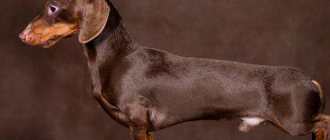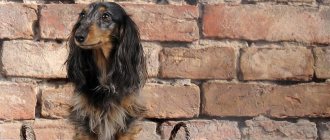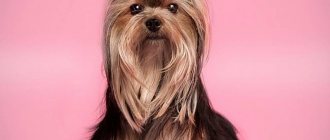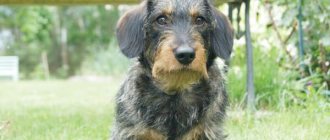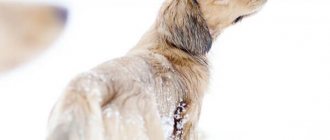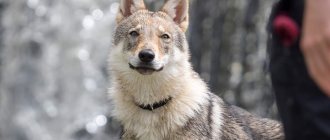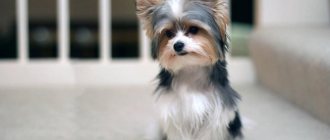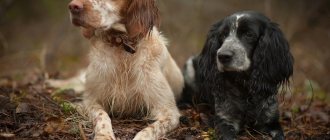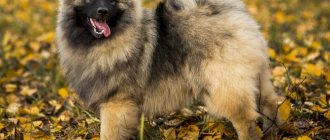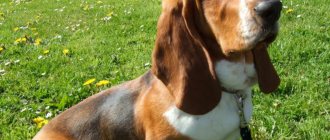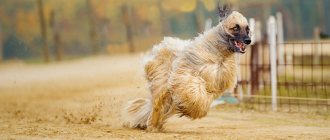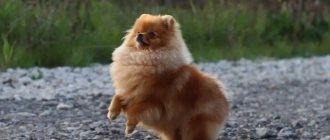The unusual merle color is found in both smooth-haired, long-haired, and wire-haired dachshunds.
These very cute dogs stand out due to their unusual coat color among other varieties of the breed.
The appearance of the marbled dachshund has a special beauty, sophistication and elegance.
The character of dogs is no different from the temperament of dachshunds of other stripes. They are also cheerful, energetic, active and smart.
However, unusual coloring is not the only feature of this type of dachshund.
“Marbling” has endowed dachshunds with certain properties that future dog owners should be aware of.
History of the origin of the breed
The marbled dachshund breed has a long history. Official information about the existence of the breed and attempts to cross it dates back to the end of the 19th century. It was then that, as a result of similar experiments, the first puppies with the double merle color (double merle) were bred in America.
The marbled dachshund has an original and spectacular appearance
However, there is an assumption that the breed has existed since ancient times, since similar images are found on ancient Egyptian frescoes.
Popular colors
Ginger
This color is very common among dachshunds. The standard recognizes all possible colors of red, from light beige-gold to dark red with a reddish tint. The most even and bright colors are highly valued. Often there is a red color with muruzina (corresponds to the standard) - black hairs varying in density and intensity.
Brown and tan
Basic brown is combined with tan tones of red. The scorch markings must necessarily contrast with the main background, the saturation of which may differ. Adult dogs should have brown eyes, but some puppies initially have gray or green irises. With age, the eyes become standard brown, so such dogs are not disqualified.
It is very rare to find individuals that appear completely brown. They still have a tan, but it is darkened. This option is not a defect, but is regarded as a disadvantage.
Black and Tan
It is considered the most classic variant of the coat color of dachshunds: on the main intense black background, there are reddish tan marks in certain places. The standard allows for a small white spot in the center of the chest.
Black
Pure black color is not recognized as a standard; such individuals are removed from breeding. Non-rejected dogs only look black, in fact they have a darkened tan that almost blends in with the base tone. When assessing a dog, they look for the presence of red hairs on the dog's paws, face or eyebrows. If such hairs are present, then the color is considered black and tan with a slight flaw.
Boar color
Visually similar to the color of boar bristles. It is traditionally called boar in any hunting breed; in other breeds it is called agouti. This coloring is an alternation of transverse black and brown areas on the hairs. The saturation of the pigment can be different, which means the overall color seems more saturated and darker or lighter. The official standard recognizes this color as acceptable only in wire-haired dachshunds; in other types of the breed, this color is considered a defect.
Marble
Two color options are recognized as standard: black marble and brown marble. Traditional tan must be present. Only these dachshunds are allowed blue irises, which is prohibited by the breed standard for other colors. Heterochromia or a blue coloration of the eye sector or even a blue sparkle is possible. The presence of blue in the iris indicates the presence of the Merle gene in that dog.
There are also double merle (it contains white color) and red merle, which are recognized as a defect in the breed.
brindle
The ideal color is one with noticeable black tiger stripes, which are evenly distributed over the entire surface. However, the color is recognized as brindle even if the red individual has only a couple of low-contrast stripes. It is interesting that these dogs often have classic brindle-colored puppies in their offspring.
Chocolate
In fact, this is an alternative name for the brown and tan color, albeit unofficial. Usually it is a classic light brown with the obligatory tan color close to milk chocolate. A brownish color with a reddish tint is acceptable.
How to get a unique marble color
Marbling is the result of crossing animals of different shades. Dachshunds have more than three hundred of them. Among them, of course, not all colors are recognized as a standard (for example, blue dachshund).
Longhaired dachshund mini and standard: description of the breed
Marbling in dachshunds is manifested by the lightening of certain areas of the body. As a result, the black and tan coloring appears as black spots with jagged edges on a lighter background. The brown and tan color gives a beige background.
Note! Any dachshund color other than red merle requires the presence of a tan.
Nutrition
The puppy's diet should be balanced. These dogs are prone to obesity and need careful monitoring of their diet. The daily diet should include:
- Meat - beef, chicken, turkey, lean lamb.
- Vegetables and fruits - carrots, tomatoes, zucchini, stewed cabbage, rarely potatoes, apples.
- Cereals - buckwheat, rice, oatmeal, boiled in meat broth.
Note! Dachshunds are recommended to use tendons and cartilage, which strengthen the jaw and clean the teeth.
Appearance of marbled dachshunds
Rabbit dachshund (long-haired): description of the breed
The marbled dachshund belongs to a rather rare and interesting breed, distinguished by its beauty. The dog is not large in size, it has short legs and a disproportionately stretched body. The animal's head is wedge-shaped, and its ears hang high.
The nose may be black or brown. The eyes are not very large, kind and wary at the same time. Dark brown color is considered ideal for them. However, sometimes there is a dachshund with blue eyes. The tail is medium length, saber-shaped. The legs are straight, short and strong.
A pet with blue eyes looks very unusual
Depending on the size, dachshunds are divided into the following groups:
- standard – weight about 9 kg, chest circumference – more than 35 cm;
- miniature (dwarf) – weight 4.5-5 kg, chest volume – 30-35 cm;
- rabbit - weight up to 3.5 kg, chest volume - up to 30 cm.
Marbled Dachshunds are classified from one another based on the type and quality of their coat. In particular, there are smooth-haired, long-haired and wire-haired.
Important! Often, inexperienced dog owners confuse regular and double marble. You need to know that double merles are characterized by the presence of large white spots. Most often, this color appears when mating two marbled dachshunds.
Purpose
Dachshunds are hunting dogs designed to hunt foxes and hares, as well as burrow-dwelling beavers, badgers and otters. Among hunting dogs, dachshunds are the smallest, but the most courageous and confident. Since ancient times, many hunters are satisfied with the choice of the smartest breed of dachshund dog. Climbing into a hole, the dachshund fights in a dark and narrow hole, relying only on itself, knowing that the owner will not be able to help. It is also common for dachshunds to hold prey in a hole until the owner opens the hole.
Caring for Longhaired Dachshunds
The marbled longhaired dachshund needs frequent brushing and periodic hygienic haircuts. You need to bathe your animal as needed, but preferably no more than 2-3 times a year.
A long-haired dachshund will need regular brushing and trimming.
Caring for Dachshund Nails and Eyes
You need to monitor the condition of your dachshund's eyes, claws and teeth every day. They should be cleaned if necessary. Nails are trimmed on average once a month. If inflammatory processes occur, you should definitely contact a veterinarian.
Photo gallery
Nature has endowed dogs of this species with elegant colors and a wide variety. In the photographs below, you will see the beauty and grace of these cute animals.
How to choose a puppy
You should only choose a marble puppy from a trusted nursery. At the same time, it is important to carefully study the baby’s pedigree in order to avoid buying a puppy that carries two marbling genes. The fact is that double marble negatively affects the dog’s health: it is more susceptible to various infections and more often suffers from problems with vision and hearing.
Also, when choosing a puppy, you should know that the sharper the color contrast in the baby, the more impressive he will look as an adult, since the fuzzy spots darken and merge with age.
The price of a puppy with a pedigree ranges from 30-35 thousand rubles*. If there are flaws in the exterior, the price is significantly reduced, but show-class babies can cost from 60 to 90 thousand.
The greater the color contrast in the puppy, the more impressive the adult animal will look.
Training
Dachshund training begins as early as possible. Some rules that will help raise a dachshund:
- Before showing what to do, you must say a command.
- Don't distract your dog while executing the command.
- Do not give the treat until the dog has completed the command.
- Always pronounce commands in the same tone and clearly formulated.
Before teaching a dog commands, it is necessary to formulate principles of education, such as:
- Teach the dog its name.
- Train him to use a collar and leash.
- Toilet and outdoor training.
- Get used to your absence.
Advantages and disadvantages of the breed
The undoubted advantages of the marbled dachshund are:
- spectacular and unique appearance;
- energy and endurance;
- insightful mind;
- developed hunting abilities;
- good attitude towards children, however, provided that the animal was not offended;
- long lifespan;
- security qualities in the absence of aggressiveness towards strangers.
The breed is not without some disadvantages:
- There are hereditary diseases characteristic of the breed.
- An insatiable appetite often leads to overeating and excess weight.
- In the absence of proper upbringing, they grow up stubborn and wayward.
- During walks they like to bark at other dogs.
- They love to dig up the ground, as a result of which house plants and garden beds often suffer.
The marbled dachshund is a beautiful breed of dog, distinguished by its original color, energy and endurance. Often, when the marbling gene is dominant, she has blue eyes.
The Marbled Dachshund is a natural hunting dog, but it needs to be trained from an early age, otherwise it can grow up stubborn and wayward.
Pet character
The behavior of marbled dachshunds does not have any specific characteristics.
These are kind, affectionate animals, endowed with natural intelligence and endurance.
This breed is perfect for families with small children.
Dachshunds get along well with kids, and they also love to play outdoor games.
Being excellent hunters, agile dachshunds have such character qualities as cunning, fearlessness and independence.
When purchasing such a pet, you should remember that dachshunds are willful.
The dog will remember the insult for a long time. Therefore, physical punishment is absolutely unacceptable in her upbringing.
The best way to teach a dog a lesson is to leave him in another room, stop playing and not pay attention to the prankster for a while.
Punishment and swearing will not only not help, but will also worsen the dog’s attitude towards you.
The intelligence of an adult marbled dachshund is comparable to that of a four-year-old child.
Reviews
Lyudmila: “While our Linda was a puppy, she managed to ruin her slippers, tore the wallpaper and scratched the furniture. When the dog frolicked, things flew in all directions. But the dachshund was so cute that we didn’t give up our pet. Now this is a well-behaved mother. Linda recently gave birth to some cute puppies and is looking after them.”
Boris: “When I bought a hunting rifle, my friends gave me a long-haired dachshund. At first I was offended by them, mistaking them for a joke. But the very first foray into the forest brought good luck - the Hussar quickly found a hole and extracted a hare from it. I think now a gun is superfluous for hunting.”
Olga: “When I saw a dachshund, I fell in love with this breed. The dog is so beautiful, elegant, and looks with an intelligent look. Now Marquise is pregnant and I ordered a puppy from her.”
If you want to have a loyal friend with four legs nearby, long-haired dachshunds will be an excellent choice. The pet's docile, playful character will bring a special atmosphere to your home.
Content Features
So when intruders are outside the door, it makes a noise.
This deters criminals because they cannot tell what size dog is in the apartment. By its nature, a pet will never raise unnecessary alarm and will not bark at the slightest rustle, such as shepherds or terriers. They are ideal for keeping in an apartment not only for their size, but also for their neatness and cleanliness. The merle dachshund is easy to litter train.
Although the dog is playful by nature and loves attention, it is neat and almost never misbehaves. Therefore, you don’t have to worry about the white carpet in the living room, for example.
Such a pet, despite its small size, is respected by other dogs. Even large dogs do not dispute the seriousness of the animal’s intentions and authority. After all, first of all, this is a hunting dog, hunting is their meaning of life.
Even if the marbled curiosity has never been on a hunt, it realizes its instincts by digging rodent holes in the park or in a summer cottage. Moreover, she is so inquisitive. While walking, he strives to explore everything around him.
This will be an ideal option for a family. The pet chooses one owner. In communication, the marbled beauty is calm and playful.
- Loves comfort and coziness. So he often jumps into the owner’s arms or onto the sofa. The pet is good with small children so if you have a small child and want to get a dog, then this would be an ideal option.
Moreover, as mentioned above, the marbled dachshund has a good guard instinct. So the home will be in perfect order.
Often the tiger dachshund and the marble dachshund are confused even by dog handlers (not very experienced ones). After all, this is not a reason for wives to give up a puppy.
Rare colors
White-spotted
The basis of this color is white, along which large spots of reddish-brown or black are located in a chaotic manner.
Two-color
The opposite of the white-spotted pattern: white spots on a dark background should occupy no more than 50% of the body. The color is not recognized as an official standard.
Blue
This coat color is distinguished by a noticeable bluish tint with a basic silver-steel or graphite-gray tone. Tan may be present. Such dogs are very impressive, the color looks unusual. It is not recognized by the breed standard.
Grey
This color is similar to blue, but with a slightly warmer shade of coat color, there is no bluish tint. The darkened tan can move closer to the main color until it completely merges visually.
Sable
The highlight of this rare color is the uneven color of each hair: there is a black pigment at the tips. Visually, it looks like a dark coating on the dog’s fur. This color may differ in the color of the “spraying”: the pigment will not be black, but brown.
Description
Along with other purebred dogs, long-haired dachshunds have an official appearance standard. Even a minimal deviation from the norm may indicate rejection. The maximum height of an adult dog at the withers does not exceed 35 cm. The standard weight of an adult varies between 9 kg. The shedding of the long-haired dachshund variety proceeds according to the season; the process of hair loss itself is moderate and does not bring trouble to the breeder.
Representatives of long-haired dachshunds have different variations in color. They can be single-color, two-color, or spotted. The coat itself is long, flowing down, and quite thick. A distinctive feature of the breed is its dense undercoat, which warms the animal in winter. The dachshund's head has an oblong shape with oval transitions that taper smoothly and evenly towards the tip of the nose.
The high-set ears are very soft to the touch and quite long. Breeders note their high mobility. The Dachshund's body should be smooth, with slight muscularity. According to body structure standards, the chest area of a dachshund should protrude slightly. The belly is tucked in. The harmoniously built limbs of a miniature body should be muscular and bony. The tail is located in the upper part of the body, slightly curved at the tip.
The dachshund has a moderately long body, slightly squat and compact in size. Excellent muscles allow it to develop good speed and endure long journeys on its paws. Despite such a short stature, the animals do not experience a feeling of discomfort or difficulty while moving. On the contrary, dogs show perfect control over their body and are able to overcome the most difficult obstacles.
A distinctive feature of the dachshund is its strong claws, thanks to which they can easily dig up the ground. In a minute of intense work, a furry animal can dig a hole 45 cm deep.
